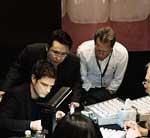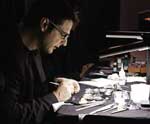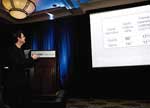New face of veneers
Dental Lab Products | April 2009 Forward Trends: Veneers New Face of Veneers Advanced materials, technologies, and procedures for creating esthetic, durable veneers can expand profitable revenue streams even in a tight cosmetic market. by Richard Palmer Photo: Den-Mat Corp.
Dental Lab Products | April 2009
Forward Trends: Veneers
New Face of Veneers
Advanced materials, technologies, and procedures for creating esthetic, durable veneers can expand profitable revenue streams even in a tight cosmetic market.
by Richard Palmer

Photo: Den-Mat Corp.
What a difference a year makes. In spring of 2008, the U.S. and world economies were shaky, but hadn’t shown many signs of their eventual crumbling, just yet. Then in the fall, the official word came that we had, in fact, been experiencing a recession for nearly a full year. But the worst was still to come with failing banks, falling stock prices, soaring unemployment, and growing anxiety of an uncertain future in spite of a new administration.
Back then, the dental profession was still riding high on the economic boom that had been rolling along during the previous few years and had stirred demand for cosmetic procedures of all sorts from patients-from chairside bleaching to full-mouth revamps. Lab owners responding to a direct-mail survey in April 20081 indicated the majority (55.8%) had experienced increased demand for restorations for strictly cosmetic purposes over the past year, while more than two-thirds (70.5%) reported an increase in cosmetic work stretching back over the previous five-year span.
In both of these categories in the 2008 survey, less than 4% said the demand from dentists for strictly cosmetic restoration had decreased in the designated time period (3.4% over one year, 2.9% over five years). Overall, the business of creating cosmetic restorations was healthy and robust for the dental lab industry. →
What goes up
Pressing power
Preferred veneer fabrication techniques*
Pressing 63.2% Refractory die 31.1% Foil 18.9% CAD/CAM milling 14.7% Other
2.6%
The fee remains
the same
63.5% of lab owners do not charge different fees for different types of veneers such as ultra-thin veneers.
Source: DLP April 2009 Veneer survey
Economic impact
The global financial crisis is more than likely a key factor in how lab owners see the demand on their veneer business.
Past 2 years 2009** Increased 31.8% 28.1% Decreased 21.9% 20.8% Stay the same 46.4% 51.0%
** Anticipated
Top 3
Which communication media do you receive from your dentists with a veneer case?*
Stump shade 77.8% Photos 77.3% Diagnostic/
provisional cast 73.5%
What information would help improve veneer results?*
Better prep 72.8% Photos 62.0% Diagnostic cast 59.2%
*Multiple responses accepted.
Source: DLP April 2009 Veneer survey.
Though dentistry is often thought of as fairly “recession proof,” the turmoil that has affected the global economy was bound to have a trickle-down effect. “Since October, we’ve seen a little bit of a drop, and it hasn’t picked up yet,” said Keevin Shigenaka, CDT, General Manager of All-Ceramics at Glidewell Laboratories. “That’s across the board. Last month, we were up just barely 0.5%, and we were ecstatic about that.” In talking with others in the lab industry, he has heard that many laboratories are not breaking even so far this year. Without the benefit of insurance reimbursement paying for elective restorative work, cosmetic-based dental procedures, both in-office and indirect, are paid for by patients directly out of pocket and driven primarily by emotion for wants-based rather than needs-based reasons. In an economic down-turn such as now, consumers and patients tend to reign in discretionary expenditures in anticipation of potentially worsening finances. “Right now, people are holding on to their money,” said Shigenaka. “But that doesn’t mean they don’t plan to use it. Everyone’s concerned, but at the same time, how much is everyone really altering things?” Veneer placement is one such cosmetic treatment that the recessionary economic situation appears to have affected already. The latest DLP exclusive survey2 shows veneer work has tapered compared to previous years. Less than one-third (31.8%) of survey respondents indicated an increase in veneer cases in the past two years, with the remaining percentage of labs reporting either a flatline (46.4%) or decrease (21.9%).
Can still go up
Even though most survey participants2 believe demand for veneer cases will stay the same (51.0%) or even decrease (20.8%) this year, the design behind cosmetic materials and fabrication techniques continues to evolve. In addition, the professional marketing campaigns by laboratories like Glidewell with its proprietary Vivaneers brand or Den-Mat’s well-known Lumineers brand (which it also markets directly to patients) has brought the option of veneers as an easy smile makeover within the financial grasp of patients and provided laboratories and practices with the means to increase elective treatment acceptance.
Veneer fabrication has transformed from the time-consuming, labor-intensive, and technique-sensitive process of refractory model or platinum foil build-up of porcelain powders by the highly trained ceramist, to the less-technique-sensitive wax-and-press processes performed by a technician with skills that can be aided by preformed or custom printed/milled wax forms, to the dental technologist working at a CAD/CAM workstation and designing veneers to be milled from ceramic or lithium disilicate blocks.
CONTINUED ON NEXT PAGE
{NEW_PAGE}
Not a lost art



The artistry involved with hand-building veneers through refractory or foil techniques is still popular with many high-end labs due to the exceptional custom esthetics that are achievable. Master Ceramist Michel Magne, MDT, detailed the sensitive techniques involved through hands-on demonstrations and a scientific lecture during Jensen Dental’s Thrive09! educational event in Chicago.
Photos: Jensen Dental
“A lot of people can do a good job with refractory or foil,” said Shigenaka. “But for us in our particular situation for consistency, and because we have so many people at varying levels of talent, being able to wax and press became the default way of guaranteeing that we get a certain level of quality and consistency. Pressing is the most accurate way to get a margin. Whatever you wax up, if you press right, it goes right to the margin and there is no gap.
For many laboratories, pressing is overwhelmingly the preferred method for producing veneers, partially due to multiple benefits afforded over other ceramic materials.
“It’s much easier to train someone to carve a tooth in wax than it is to build and shape it in porcelain,” said Keith Miolen, Technical Director at Craftsman Dental Lab of Beacon, N.Y.
In addition to traditional hand carving of waxes for pressing veneers, newer materials have been introduced to the market that eliminate much of the manual labor and skill necessary to form the tooth. Preformed wax patterns can greatly speed up and regulate the process, while polymer blocks can be custom designed and milled via applicable CAD/CAM systems. Laboratories also can utilize the services of outsourcing services to generate 3D printed wax patterns or purchase the software and hardware for in-house printing if working with a high volume of pressing cases.
“What used to be in the hands of a ceramist now is in the hands of a good waxer,” said Miolen. “It’s changing the way lab owners hire and the way they structure their labs.” He added that technicians who can be trained to wax also are easier to employ than ceramists, who have years of training and experience, but who also are retiring and leaving lab owners with a difficult time finding replacements.
In addition to veneers, pressable materials can be used to create all-ceramic single-unit inlays, onlays, and anterior crowns as well as multi-unit bridges or posterior crowns with a metal or zirconia substructure (depending on the particular material). This versatility facilitates shade matching of adjacent and opposing restorations. Pressing also affords finishing options as the technician can simply stain and glaze the pressed full-contour restoration or cut-back and layer with compatible porcelain for added esthetics.
“If I’m doing multiple units, I just stain and glaze the anterior. But if it’s just one or two units, I will layer because I’m matching natural dentition. If I’m making all the teeth in the anterior, then I can stain and glaze and make everything match,” said Miolen. “That just makes my lab so much more productive and efficient.”
Thin is in
With traditional leucite and feldspathic pressable materials there is a limit to just how thin the veneers could be pressed. The standard 0.6-mm-thick pressed veneer requires the clinician to grind the surface enamel of the tooth, which then requires the use of provisional restorations while the veneers are fabricated in the lab as well as bonding the veneers in place. Around five years ago, Den-Mat Corp. introduced Lumineers ultra-thin (0.3-mm) pressed feldspathic veneers that require minimal or no prep by the dentist, which at first caused some concern in the dental profession.
“General dentistry frowned on the procedure, and so did Glidewell,” recalled Shigenaka. “If you don’t reduce any tooth structure, you’re adding on. It’s going to be bulky, it’s not healthy, and you’re creating a speed bump down at the gingiva.”
However, after numerous cases were placed by Glidewell’s in-house clinician Dr. Michael DiTolla and the endorsement by Dr. Gordon Christensen of Den-mat’s Lumineers ultra-thin veneer and the no-prep technique in general, Shigenaka said Glidewell saw the no-prep veneers as a valuable treatment option and the wave of the future. “The reward factor for the patient is so great that you realize that you are doing a good service, and you are doing legitimate dentistry,” he said.
According to Shigenaka, Glidewell ceramic engineers set out to develop their own pressable ceramic capable of pressing to 0.3 mm for no-prep veneers and eventually came up with a leucite-reinforced feldspathic porcelain that is a variation of a layering ceramic and available in a range of opacities. “That became our entry into the market,” he said.
Like Den-Mat (as do several other labs), Glidewell markets its own Vivaneers brand direct to dentists as a no-prep, non-invasive smile makeover option. However, Glidewell also developed the material for labs to use for in-house veneers known as Prismatik ThinPress, and just recently Ivoclar Vivadent launched IPS e.max Press lithium disilicate material in both low (LT) and high (HT) translucencies for ultra-thin veneers. In addition, Pentron Ceramics now offers Press.tige pressable material for ultra-thins, which Miolen has been using for several months.
“A material that can be pressed this thin makes my lab more productive because now I can incorporate more waxups into my rings as well as press the thin cases,” said Miolen.
According to the DLP veneer survey, 40% of lab owners have added ultra-thin minimum-prep veneers to their services.
Miolen added that because it also can be used to press full-contour units, he has been able to up-sell cases where the dentist has prescribed a single restoration but where adjacent teeth are asymmetrical or out of arch form and could benefit from a thin veneer with no preparation.
“I’m actually calling doctors up promoting more veneers on cases where they do not prescribe a veneer. All I have to do is press it and send it,” he said. “It idealizes their smile, and the doctor doesn’t have to prep. I now aid the doctor in treatment-planning a better smile for the patient.”
Eddie Corrales, Owner of Downtown Dental Designs in San Diego, confirms the add-on benefits of pressing ultra-thin veneers as an adjunct to non-veneer cases. “That’s something that I, and a lot of good technicians, have a good eye for-the improvement of the case,” he said. However, he does recommend that such case upgrades be limited to good clients to ensure payment.
Shigenaka mentioned that Dr. DiTolla frequently uses no-prep veneers in his practice for certain cases to fill out a smile, which benefits the laboratory, practice, and patient.
“From the lab’s perspective, it’s a great tool to generate revenue and to get a higher success rate on the restoration because it just blends everything better,” he said. “For the doctor, you’re offering the additional revenue stream. The patient is more likely to go for it. [The clinician] can give a really great price [because of the lack of additional prep time], and feels like he’s getting a deal.”
CONTINUED ON NEXT PAGE
{NEW_PAGE}
CAD/CAM veneers
More commonly used to mill substructures for zirconia-based crowns and bridges, CAD/CAM technology also has applications in the production of veneers, beyond the milling or printing of wax/resin patterns for pressing. Although pressables command the heft of use for veneer fabrication, a healthy 14.7% of lab owners responded to the DLP survey that they use CAD/CAM to mill their veneers.
Bill Atkission, Owner of Bill Atkission Dental Ceramics in Oceanside, Calif., has been using Vident’s Mark II feldspathic blanks on the Sirona inLab system to mill anterior veneers since 2006, prior to which he was pressing.
“I prefer to do these and talk my doctors into doing them,” he said, though he adds that the milled veneers aren’t suitable for all cases, such as patients with heavy bruxism.
In addition to Vident, Ivoclar also offers millable blocks for use in the inLab CAD/CAM machine in the form of IPS Empress CAD leucite-reinforced glass-ceramic and the IPS e.max CAD, though they are indicated only for standard (not ultra-thin) veneers.
Atkission indicated he hasn’t had the opportunity to mill the newer IPS e.max CAD HT blocks (which were just launched this year), but said he would likely use them in cases that require the additional strength of the lithium disilicate material.
One minor downside to milling veneers is there are no blocks specifically shaped and sized for the thin restorations. Using a standard block results in wasted material and extended milling time because only one veneer can be milled at a time.
Shigenaka says that Glidewell does a certain percentage of its veneers through CAD/CAM with consistent results that require minimal hand finishing. “As the materials become more usable and more practical, that’s really going to increase,” he said. He added that for single veneers, he’s more likely to press.
Den-Mat produces the Lumineers with Cerinate through pressing, though Den-Mat Director of Marketing Kim Ferrari said another Lumineers veneer option is a milled lithium disilicate. In addition to using CAD/CAM to produce the veneers themselves, Den-Mat also incorporates the technology to generate an innovative tray delivery and placement system called LUMITray as well as a tooth-preparation guide called LUMIKey. “It’s actually better for the dentist getting into thin veneers,” said Ferrari. “We take the technique sensitivity out if it. It’s a hard material that won’t let you overprep.”
While clinicians have the option of milling veneers at chairside on Sirona’s CEREC machine or the E4D chairside CAD/CAM system distributed by Henry Schein, the technology has limited appeal for the majority of practitioners due to the hands-on processing steps involved-such as the detailed staining, glazing, and polishing-to create natural-looking single-visit restorations. However, the CEREC system starts with a digital impression that can be electronically sent to a laboratory for veneer design, milling, and finishing. Other intraoral capture devices, like Cadent’s iTero or 3M ESPE’s Lava C.O.S., as well as extraoral scanners, like Zahn’s Dental Wings or Nobel Biocare’s brand-new NobelProcera, that can scan the internal aspects of a poured impression tray and generate a digital model, offer labs and practices a model-less option for veneer cases, which shortens turnaround time.
“Everyone’s fascinated with this kind of technology, but I think the vast majority of labs are still doing it the traditional way,” said Shigenaka, though he cautions that laboratory owners “should know that CAD/CAM or pressing maximizes their efficiency.”

RELATED ARTICLE
Keith Miolen of Craftsman Dental Lab illustrates a veneer case using Pentron’s new Press.tige pressable ceramic. Click here.
References
1. The DLP April 2008 Cosmetic Survey was direct mailed to a random sampling of 1,000 lab owners in the United States in February 2008. Statistics were tabulated from 159 returned surveys, for a response rate of 15.9%.
2. The DLP April 2009 Veneer Survey was direct mailed to a random sampling of 2,730 lab owners in the United States in February 2009. Statistics were tabulated from 195 returned surveys, for a response rate of 7.1%.
Product Bites – January 19, 2024
January 19th 2024Product Bites makes sure you don't miss the next innovation for your practice. This week's Product Bites podcast features new launches from Adravision, Formlabs, Owandy Radiology, Henry Schein Orthodontics, Dental Creations, and Dental Blue Box. [5 Minutes]
Product Bites – December 22, 2023
December 22nd 2023The weekly new products podcast from Dental Products Report is back. With a quick look at all of the newest dental product launches, Product Bites makes sure you don't miss the next innovation for your practice. This week's Product Bites podcast features updated software from Medit. [2 Minutes]